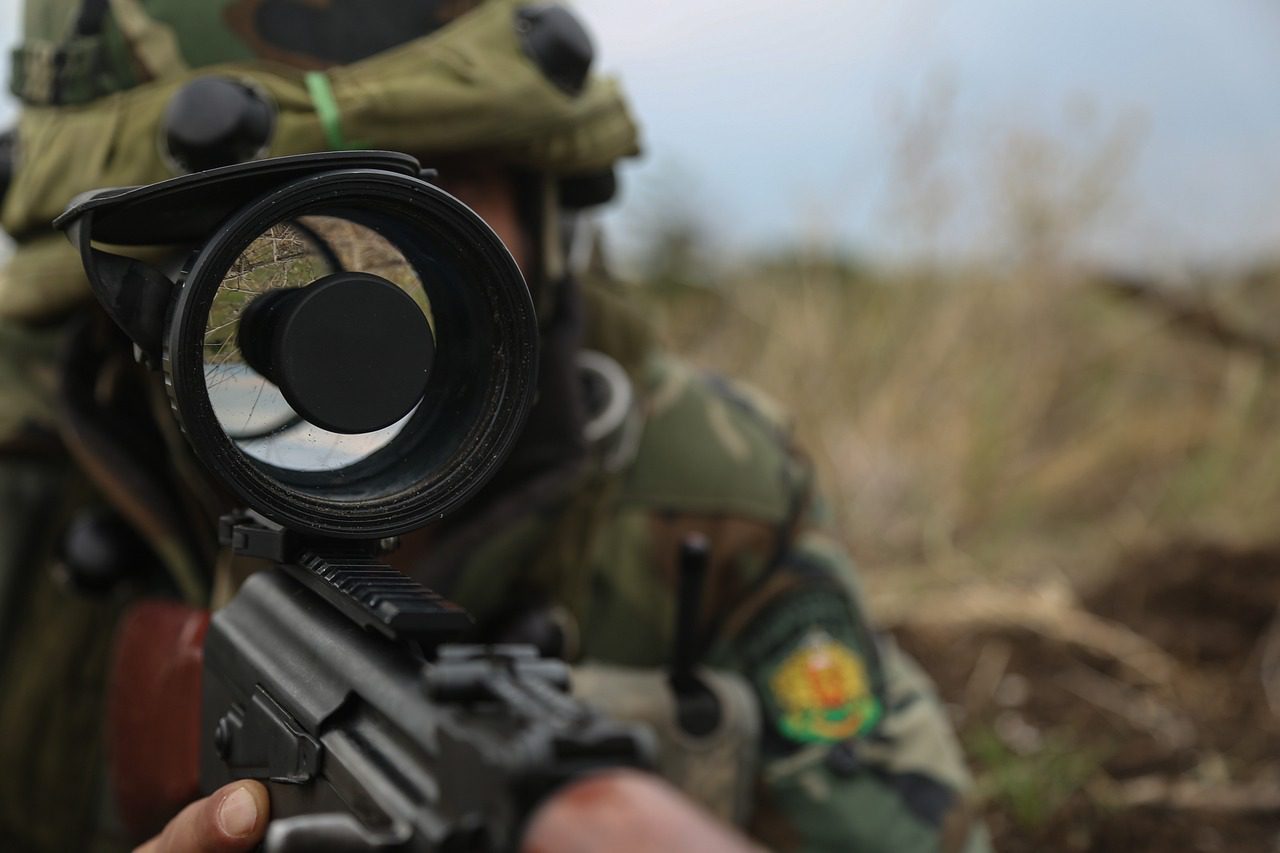Curiosity piqued, we find ourselves pondering the capabilities of military night vision gear when it comes to tracking animals. With its advanced technology and ability to navigate the darkness, one wonders just how far this impressive equipment can allow us to see.
In this article, we will explore the range of military night vision gear and how it can be used to track animals effectively.
From stealthy predators to elusive prey, join us as we embark on a fascinating exploration of the effective range of military night vision gear in the pursuit of animals.
Range Of Military Night Vision Gear
Night vision technology has revolutionized the way we perceive and navigate the world after dark. Whether it’s for military operations or wildlife observation, having the ability to see in low-light conditions is invaluable.
From understanding the technology behind night vision gear to the factors that affect tracking range, we’ll delve into every aspect of this fascinating subject.
Understanding Night Vision Technology
To fully grasp the range of military night vision gear, it’s essential to understand how this technology works. Night vision gear operates on the principle of electricity and light amplification.
The device uses an image intensifier tube that takes in existing ambient light, such as moonlight or starlight, and amplifies it to create a clear and detailed image.
This amplified image is then presented to the user through a display unit, allowing them to see their surroundings even in extremely low-light conditions.


This image is the property of pixabay.com.
How Night Vision Gear Works
Night vision gear consists of several components that work together to provide enhanced visibility in the dark. The first component is an objective lens, which gathers incoming light and focuses it onto the image intensifier tube.
This tube is the heart of the night vision device, responsible for amplifying the available light. The amplified image is then passed through a series of lenses to increase clarity and resolution before being displayed to the user.
Different Generations Of Night Vision Gear
Night vision gear is categorized into different generations based on their technological advancements and performance capabilities. Currently, there are four generations of night vision gear, with each generation offering improved range and image quality.
- Generation 0: Introduced in the 1940s, these early night vision devices were large and bulky. They relied on an active infrared source to illuminate the scene, making them easily detectable.
- Generation 1: Developed in the 1960s, this generation saw significant improvements in size and performance. Generation 1 night vision gear introduced passive infrared technology, eliminating the need for an external light source.
- Generation 2: The 1970s brought about Generation 2 night vision gear, which further enhanced image quality and range. These devices incorporated a microchannel plate, resulting in brighter and crisper images.
- Generation 3: Currently, the most common generation used in military night vision gear is Generation 3. These devices utilize gallium arsenide photocathodes to provide even greater sensitivity, range, and clarity. Generation 3 night vision gear is capable of producing detailed images even in near-total darkness.
Challenges Of Tracking Animals At Night
Tracking animals at night poses unique challenges, as many creatures are adapted to thrive in low-light conditions. Their ability to blend into their surroundings and move silently can make them difficult to detect and observe.
Additionally, the limited range of the human eye in low-light scenarios puts trackers at a significant disadvantage. Without proper night vision gear, it becomes nearly impossible to effectively track and monitor animal movements after sunset.
Advantages Of Using Night Vision Gear
Night vision gear offers a myriad of advantages when it comes to tracking animals at night. By amplifying ambient light, these devices significantly extend the range at which animals can be detected and observed.
The enhanced visibility provided by night vision gear allows trackers to spot animals from a distance, reducing the chances of inadvertently disturbing them.
Factors Affecting Tracking Range
Different environmental and animal factors can impact the tracking range of night vision gear. It’s important to consider these factors when using night vision gear for tracking purposes.
Environmental Factors
- Ambient Light Levels: The amount of available ambient light directly affects the range of night vision gear. In complete darkness, the range may be limited to a few meters. However, even the faintest light sources, such as the moon or stars, can extend the range significantly.
- Atmospheric Conditions: Factors like fog, rain, or snow can hinder the performance of night vision gear. These weather conditions scatter and absorb light, reducing the visibility and effective range of the device.
- Obstacles and Terrain: The presence of obstacles, such as dense vegetation or rough terrain, can obstruct the line of sight and limit the range of night vision gear.
Animal Factors
- Size and Behavior of Animals: The size of the animal being tracked plays a crucial role in its detectability. Larger animals are generally easier to spot at greater distances. Furthermore, animals with distinct behaviors, such as moving in open spaces or emitting sounds, are more likely to be detected and tracked.
- Nocturnal Animals: Animals that are naturally adapted to low-light conditions, such as owls or bats, are more likely to blend in with their surroundings. Their specialized adaptations can make it challenging to spot them with night vision gear.
- Camouflage and Adaptations: Many animals possess natural camouflage or adaptive coloration, making them less visible even with night vision gear. These animals may require closer proximity to be effectively tracked and observed.
Military Night Vision Generations
Understanding the different generations of military night vision gear is key to comprehending their tracking range and performance capabilities.
Overview Of Different Generations
- Generation 0 night vision gear was a rudimentary system that relied on an external light source, limiting its effectiveness.
- Generation 1 marked a significant leap in technology by introducing passive infrared technology, making it less detectable and more practical for military use.
- Generation 2 built upon the success of the former, incorporating a microchannel plate for improved image quality and reduced noise.
- Generation 3, the most prevalent in military use today, boasts even better overall performance, including increased sensitivity and range.
Range And Performance Of Each Generation
Each generation of night vision gear offers varying ranges and performance capabilities. Generation 0 devices generally provide a limited range of less than 100 meters.
With the advancements in technology, Generation 1 extended the range to around 200 meters. Generation 2 extended the range further, reaching up to 300 meters.
The current state-of-the-art Generation 3 night vision gear can provide detection ranges of up to 500 meters or more, depending on the environmental and animal factors present.
Implications For Tracking Animals


The increasing range and performance capabilities of night vision gear have expanded the possibilities of tracking animals at night.
Generation 3 night vision gear, in particular, offers a significant advantage in both detecting and observing animals from a safe distance, minimizing the risk of disturbing their natural behavior.
This enhanced range allows for more accurate data collection and a better understanding of animal movements, habits, and habitats.
Limitations Of Night Vision Gear
Despite its many advantages, night vision gear also has certain limitations that must be considered when utilizing it for animal tracking.
Detection Range Vs. Recognition Range
Night vision gear has both a detection range and a recognition range. While an animal may be detectable at a certain distance, positively identifying the species and details may require the observer to be closer to it.
This distinction is important when tracking animals as it determines the level of information that can be gathered.
Effectiveness In Dense Vegetation
Night vision gear performs best in open areas or regions with minimal obstructions. Dense vegetation, such as thick forests or jungles, can significantly limit the effective range of the gear.
The foliage can obstruct the line of sight, making it difficult to spot animals that are hidden within the dense vegetation.
Interference From Artificial Light Sources
Artificial light sources, such as streetlights or car headlights, can interfere with night vision gear. The intensity of these lights may overpower the ambient light that the device relies on, causing decreased visibility and range. Care should be taken to avoid areas with excessive artificial lighting to ensure optimal performance.
Improving Tracking Range
Various techniques and equipment can be employed to improve the tracking range when using night vision gear.
Using Additional Optical Equipment
By incorporating binoculars or telescopic lenses, the observer can enhance the range of night vision gear. These additional optical tools magnify the image, giving the user a closer and clearer view of the animals being tracked.
Incorporating Infrared Illuminators
Infrared illuminators are accessories that emit infrared light, which is invisible to the naked eye but can be picked up by night vision gear. These illuminators extend the effective range by providing additional light that the gear can amplify, enhancing visibility in complete darkness or areas with extremely low ambient light levels.
Enhancing Image Resolution And Clarity
Upgrading to a higher generation of night vision gear can significantly improve the range, image resolution, and clarity. Generation 3 devices, with their enhanced features and sensitivity, can provide a clearer and more detailed view of the animals being tracked, expanding the tracking range.
Strategies For Tracking Animals
When using night vision gear for tracking animals, employing certain strategies can greatly enhance the effectiveness of the observations.
Choosing Optimal Observation Points
Selecting observation points that offer a wide field of view can maximize the chances of spotting animals. High vantage points, such as hills or elevated platforms, provide broader visibility and increase the likelihood of detecting animals at greater distances.
Using Stealth And Tactical Approaches
Animals have acute senses, making it crucial to approach them stealthily. Minimizing noise and movement reduces the chances of alerting the animals, allowing observers to study their behavior and monitor their movements without unnecessary disturbances.
Working In Teams For Better Coverage
Collaborating with a team of trained observers improves coverage and increases the range of animal tracking efforts. By spreading out across a designated area and sharing information, teams can collectively monitor a larger territory and gather more comprehensive data.
Applications In Wildlife Conservation
The range and capabilities of military night vision gear have significant implications for wildlife conservation efforts.
Monitoring Wildlife Populations
Accurate and reliable data on wildlife populations are vital for conservation initiatives. By using night vision gear, conservationists can conduct surveys and monitor animal populations after dark, providing valuable insights into population sizes, distribution, and behavior.
Preventing Illegal Hunting And Poaching
Night vision gear equips wildlife rangers with the ability to detect and track illegal hunting and poaching activities at night. By enhancing visibility and range, night vision gear plays a crucial role in enforcing wildlife protection laws and deterring illegal activities.
Research And Behavior Studies
The ability to observe animals in their natural habitat during nocturnal hours has opened up new avenues for research and behavior studies.
Night vision gear allows scientists and researchers to study the behavior, feeding patterns, and interactions of nocturnal animals without disturbing their natural habitat.
Conclusion
The range of military night vision gear has revolutionized the field of animal tracking and observation. From its inception with rudimentary technology to the present-day advancements in Generation 3 night vision gear, the ability to see in low-light conditions has greatly enhanced our understanding of nocturnal animal behavior.
By considering the various factors that affect tracking range and utilizing strategies to optimize performance, night vision gear has become an invaluable tool in the realms of wildlife conservation, research, and military operations.
As technology continues to evolve, we can expect even greater capabilities and an extended range of military night vision gear in the future.
Do Jet Pilots Use Night Vision?
What Night Vision Does The German Military Use?
Does The Military Use Night Vision Or Infrared?
What Night Vision Does Delta Force Use?
Is Military-Grade Night Vision Gear Widely Available To Civilians?





